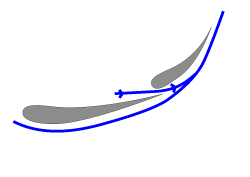Randomness wrote:Directly behind the airbox there is low pressure which is why the air flowing around it gets pulled in, and as a result more air flow reaches the centre of the wing than the outside. You need look no further than an airfoil to understand this..
We are not talking about the DRD wing here, we are talking about the curved wing vs the flat wing. The reason for my post is that whoever it was claimed that the wing produced less downforce for the same drag. But this is simply not true. That was the point. The curved wing collects more air in the centre of the wing. Because this is where the air flow is stronger. On that CFD simulation, lacking an airbox, the air reaching the wing is linear. Which means that it renders the test pretty much useless, as the wing will never be subject to airflow that is not interrupted by the airbox.
Based on everything I know about fluid dynamics, I would say what happens is exactly the opposite.
The monkey seat, for instance, was always explained to be there because of the central section receiving less airflow due to roll hoop blocking it, so the little wing(the monkey seat) is there to help create some downforce in the central section.
About the 2007-2008 rear wings that were mentioned here, those wings are more "cutted" at the sides than "enlongated" at the central. That's why they gave less drag, in that case, it gave less frontal area and also effective chord.
Sauber's new wing is not having less frontal area and effective chord than it's previous wing, it actually have more(that my visual impression, anyway). But despite having more area to produce downforce, it will provide less for the same amount of drag, and that's what the CFD test indicated.
Of course, the whole bodywork of the car, ahead of the RW, will affect how it works, but that's not the point here. Both wings will likely be affected in
roughly same manner.
I would be very surprised if, once tested with a whole car on CFD, the new wing would come out with a better L/D than the old one.
The reason for it is simple, that amount of air that reachs the RW is due to the bodywork ahead and not the shape of the wings's, themselves. If there will be less air in central section for one wing, the same will happen for the other and don't expect miracles with the change of air's mass through there.
In this case, a "miracle" would be the "spoon wing" being more effective once tested with the whole car. If you would have half(just an example to make a point) "air mass" reaching the rear wings, with whole car tested, both wings would have half air density reaching, which would imply in half the downforce.
The coefficient of lift/drag of the wings are likely to remain quite the same, in a full car test, that's my point. So, relatively speaking, in a whole car test, the old wing should(at least I guess) remain more efficient
As a note, I think everybody here know that downforce/drag is a function of: air density, area of pressure, coefficient of lift/drag, and speed(squared).
About Williams' wing used in Canada 2011, that is very different to this one. That one was cutted at the center to let the air flow more freely through there, which will result is less downforce/drag.















